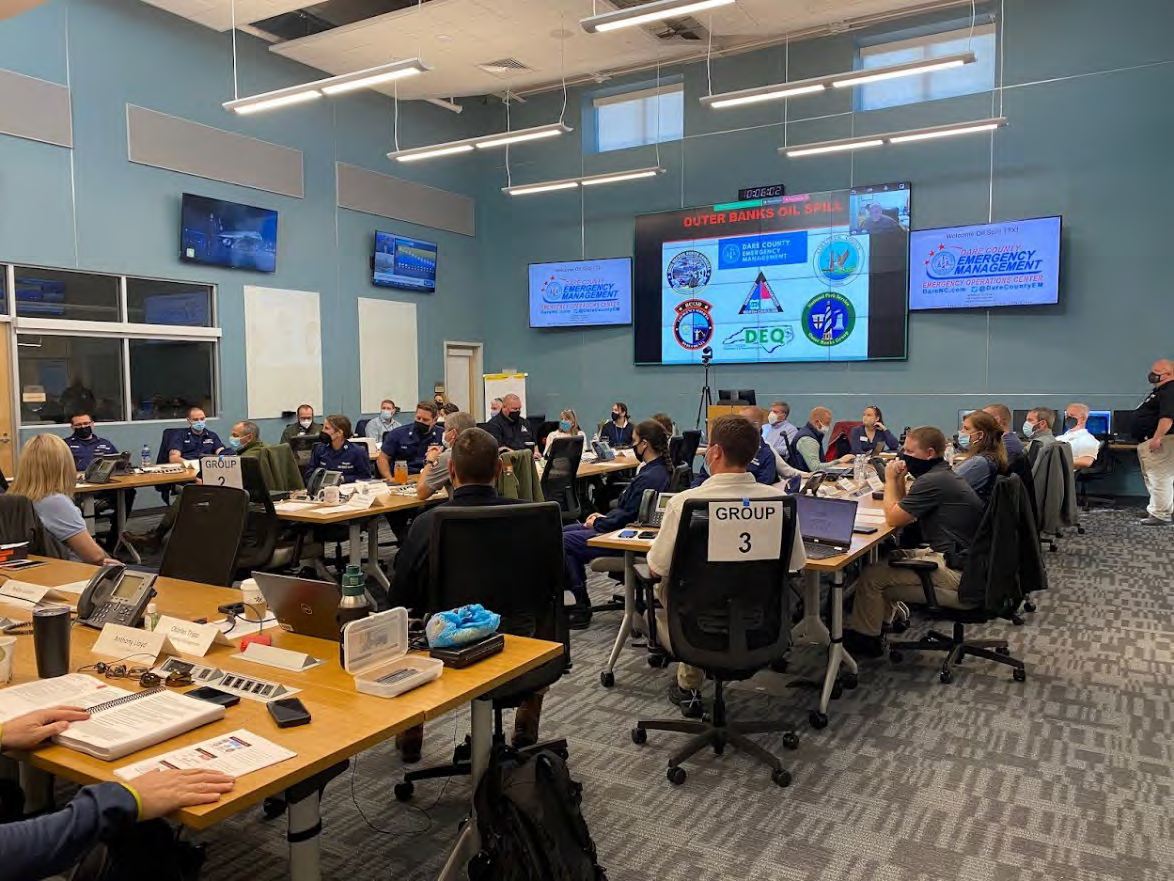
Prospective drilling at a rich deposit of fossil fuels off Cape Hatteras has long been the bogeyman for Outer Bankers. But even with the current coastwide moratorium on gas and oil exploration, oil spills can and do happen. An oil tanker can be damaged in a storm, or a cargo ship can run aground and split apart.
That scenario is what the recent Outer Banks Regional Oil Spill Tabletop Exercise was intended to address, with officials and emergency managers at every level of government gathering to update and improve plans to quickly respond to oil spills that could threaten the coast of Currituck, Dare and Hyde counties.
Supporter Spotlight
In an “after-action” plan released in late February, following the all-day exercise held on Feb. 2 in Manteo, recommendations included ways to build response skills among a wider swath of those living on the barrier islands.
“The goal is to provide more training opportunities for people who are in the community,” Drew Pearson, Dare County Emergency Management director, said in an interview.
With an integrated and broad approach to tackling spills, the exercise builds on the traditional incident command system, or ICS, approach for emergency response, while filling in gaps.
“It is a tried and tested system to bring all levels of response together,” he said, referring to the ICS.
Pearson said that after the local Outer Banks emergency management planning committee was revitalized about two years ago, several groundings of fishing vessels made it apparent that a more comprehensive plan was needed to tackle oil spills.
Supporter Spotlight
“We said, ‘How do we get smarter locally in our response?’,” Pearson recounted.
There has not been a large oil spill off North Carolina in decades, although there have been plenty of small oil leaks of varied amounts and duration from various ship mishaps and old abandoned or sunken vessels. During World War II, numerous ships lost in U-boat attacks or storms disgorged oil into the seas off the Outer Banks, sometimes igniting the surface of the water into flames.
And in March 1971, the tanker Texaco Oklahoma, located 120 miles northeast of Cape Hatteras, broke apart in a storm, leaving behind a 50-mile-wide slick of oil and claiming most of the 44 lives on board.
But more recently along a nearby Atlantic coastline, 215 gallons of oil washed ashore in October 2020 at Broadkill Beach in Delaware, polluting more than 60 miles of shoreline, including in Maryland. More than a year later, the source of the oil had still not been determined.
The exercise, facilitated by consultant Crisis Tec, featured group discussions about plans and procedures with more than 40 participants from the U.S. Coast Guard, National Park Service, National Oceanic and Atmospheric Administration, North Carolina Emergency Management, Dare, Currituck, and Hyde counties, nonprofit groups and academic institutions.
Much of the discussion was spurred by a hypothetical oil spill from a large oil tanker transiting off the North Carolina coast during a tropical storm.
Participants could view trajectory maps of the 5,000 gallons of oil spilling into the ocean every hour as the vessel drifted to the beach, and the additional 200,000-gallon release when the ship grounded.
Based on the projected impacts, each group discussed how a multi-organizational response, mitigation and recovery could be made under existing plans, and where there was room for enhancement and updating of the plans, such as in the notification systems.
According to the report, the purpose of the exercise, which was funded from North Carolina Emergency Management’s $7,500 Tier II Competitive Grant, was to “examine current policies, procedures, resources and actions in the context of a response to major oil spill, to promote greater understanding and ability to manage a complex incident and to make improvements as identified as an outcome of the exercise.”
Oil spill regulations are covered under Title 40 of the U.S. Code, and the Coast Guard has authority under the 1990 Oil Pollution Act to act as the federal on-scene coordinator to respond to spills in the marine environment.
Other laws that govern oil accidents include the Federal Water Pollution Control Act, the Clean Water Act and the Oil Spill Liability Trust Fund.
Lt. Amanda Faulkner, an emergency management specialist for Coast Guard Sector North Carolina, said that as part of the National Response Framework, there is an area contingency plan in place that guides the Coast Guard’s response to hazardous substance releases and oil spills. The contingency plan is overseen by an area committee, a group of federal, state and local government stakeholders from the specific area of the country.
In North Carolina, she said, the area spans the coastal environment from the Virginia to South Carolina borders.
In addition, the laws require every regulated vessel to have response plans to prevent environmental impacts in the event of a discharge. The Coast Guard also regularly inspects vessels to ensure their compliance to regulations.
Although the area committee does hold annual exercises, she said, the Coast Guard has typically been the lead organizer for oil spill drills. With the Manteo tabletop exercise, she said, the effort was unusual because it was not only spearheaded by Dare County, the county also took “a very active role.”
Dare County Emergency Management has encouraged attendees at the exercise to join the ongoing efforts to enhance the North Carolina Coastal Area Contingency Plan managed by Coast Guard Sector North Carolina.
The Coast Guard supported and helped to develop the Manteo after action report, Faulkner said, and it welcomes efforts to partner on proactive plans.
“I think we always have something that we can improve on,” she said. “And that’s the importance of doing these tabletop exercises and the full-scale exercises, is to identify those gaps and work to address them.”







